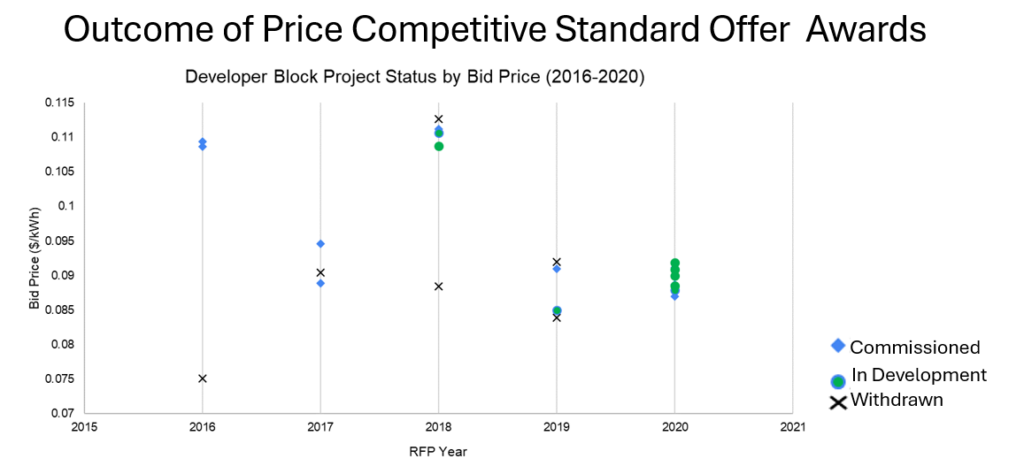REV’s 2025 legislative priorities lay the foundation to cost-effectively reach the increased renewable energy requirements in Vermont’s new landmark 100% Renewable Energy Standard. REV will continue to prioritize legislative and regulatory changes that allow for the predictable, efficient, and cost-effective deployment of renewable energy in Vermont and throughout New England.
Making it Easier to Go Solar at Home: 25kW is the New 15kW
As more and more Vermonters electrify their homes and businesses by switching to EVs and heat pumps, they are also looking to generate more of their own power from solar.
Unfortunately, a law passed in 2014 limits the use of a speedy and convenient registration process for ground-mounted solar arrays to projects that are 15kW or smaller (all roof-mounted net-metered projects can use this process regardless of size). Anything larger than 15kW must use a lengthy application process that adds so much time, uncertainty and cost to a project that almost no homeowner undertakes it. Since 2020, according to REV’s research, only 11 applications have even been filed for projects between 15 and 5kW.

REV will be asking the 2025 Legislature to raise this 15kW cap to at least 25kW, allowing more homeowners to meet the power needs from electrification with their own solar generation.
This change is largely made possible by the increased efficiency of solar panels since the law was written. Before 2017, most residential solar panels had a capacity of about 250W. Modern residential solar panels are 485W or more. This allows for a 28% increase in generation in roughly the same physical footprint.
Building a 25kW array instead of a 15kW array produces enough extra electricity every year to power a Ford Lightning for over 25,000 miles!
Reauthorizing Vermont’s Standard Offer Program
The update in 2024 to the Renewable Energy Standard (RES) will require a dramatic increase in the deployment of distributed generation in Vermont. Outside of the state’s net-metering program, Vermont does not have any renewable generation procurement programs or incentives as the authorized capacity in the Standard Offer program has been filled.
The Standard Offer program was established in 2009 to promote the deployment of distributed renewable generation up to 2.2MW in size. The program was initially authorized to procure 50 MW of generation which the Legislature later increased to 127MW. From 2013 through 2022, the Public Utility Commission issued an RFP for 5-10MW of capacity annually, with the lowest-priced qualified bids awarded Standard Offer contracts.

REV’s research found that Standard Offer has been a very successful program at getting solar projects built at cost-effective prices: of the 78 solar projects that have been awarded Standard Offer contracts 47 are now in operation, 13 projects have been withdrawn and 18 are still in permitting or construction.
For this update to Standard Offer, REV is recommending:
- A capacity of 20 MW a year for five years. The original program peaked at 10 MW/year but that was against a RES requirement that needed roughly 25 MW/yr to fulfill. The new RES will need ~70 MW/yr by the end of the decade.
- Increase the size of projects eligible to bid on Standard Offer from 2.2MW to 5MW to better align with the requirements of the RES.
- Eliminate Standard Offer’s procurement from landfill methane and other technologies generating electricity from processes that create greenhouse gas emissions. There is no need to require energy from sources that contribute to climate change.
- Have two rounds of bidding a year rather than one to allow for more accurate pricing based on changes in market conditions.
- Have a small set-aside for community solar projects, with a price cap. If community solar projects didn’t fully subscribe, this capacity would revert back to other solar projects in the Standard Offer Program.
Establish an Equal Process for the Environmental Review of Distribution Upgrades
Historically, Vermont utilities have managed the process of environmental assessment and permitting for upgrades to existing distribution infrastructure when new renewable energy projects are interconnected. However, increasingly, the Agency of Natural Resources (ANR) is requiring developers to conduct an environmental assessment of the entire upgrade corridor as part of the CPG process. Most of these upgrades happen in already disturbed areas like roadsides as in the picture below.
Example of a Distribution Upgrade from a Vermont Solar Array

This change in practice by ANR creates multiple problems including delays, infringing on landowners, uncertainty in liability, etc in the permitting process without providing any additional environmental benefits and puts requirements on renewable energy projects that are different than all other types of development.
As an example of needed distribution upgrades, since 2020, Vermont utilities have moved or installed over 6,500 poles. REV is unaware of any significant environmental issues caused by the utilities’ management of these distribution upgrades.
The 2025 Legislature must direct ANR to clarify that upgrades required for solar projects be treated like all other projects which allow the utility’s permitting process to manage environmental impacts. Click here for more information on this much-needed reform of the permitting process for solar projects
